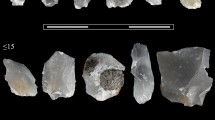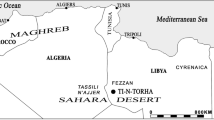Abstract
Fossils from Olduvai Gorge, Tanzania, show cutmarks which establish that hominids were using stone tools on animal tissues during the Lower Pleistocene in Africa. We identified cutmarks by elimination of other likely causes of the marks on the bone surfaces, for example, gnawing or chewing by carnivores or rodents, and damage made by tools of excavators or preparators. This was achieved by comparing the marks on the fossils with those produced by known causes on modern bones, using scanning electron microscopy (SEM). Because the fossils occur as part of accumulations of animal remains in relatively undisturbed geological contexts, we conclude that there is a functional association between the stone artefacts and bones at these sites, rather than an accidental, postmortem association1,2.
Similar content being viewed by others
References
Leakey, M. D. Olduvai Gorge Vol. 3 (Cambridge University Press, London and New York, 1971).
Hay, R. L. Geology of the Olduvai Gorge (University of California Press, Berkeley, Los Angeles and London, 1976).
Shipman, P. Ann. N.Y. Acad. Sci. (in the press).
Lanyon, L. E. & Smith, R. N. Acta orthop. scand. 41, 238–248 (1970).
Evans, F. G. Mechanical Properties of Bone (Thomas, Springfield, 1973).
Lakes, R. & Saha, S. Science 208, 501–503 (1979).
Bonnichsen, R. Pleistocene Bone Technology in the Beringium Refugium Archaeological Surv. Canada 89 (1978).
Sadek-Kooros, H. Am. Antiq. 37, 369–382 (1972).
Brain, C. K. in Human Origins (eds Isaac, G. Ll. & McCown, E.) 97–116 (Benjamin, Menlo Park, 1976).
Walker, A. Phil. Trans. R. Soc. B292, 56–64 (1981).
Potts, R. (in preparation).
Guilday, J. E., Parmalee, P. W. & Tanner, D. P. Penna Arch. 32, 59 (1962).
Frison, G. C. Plains Anthrop. 16, 258 (1971); The Casper Site (Academic, New York, 1974).
Isaac, G. Ll. Scient. Am. 238(4), 90–108 (1978).
Tanner, N. & Zihlman, A. Signs 3, 585–608 (1976).
Binford, L. R. Nunamuit Ethnoarchaeology (Academic, New York, 1978).
Jolly, C. J. Man 5, 5–20 (1970).
Author information
Authors and Affiliations
Rights and permissions
About this article
Cite this article
Potts, R., Shipman, P. Cutmarks made by stone tools on bones from Olduvai Gorge, Tanzania. Nature 291, 577–580 (1981). https://doi.org/10.1038/291577a0
Received:
Accepted:
Issue Date:
DOI: https://doi.org/10.1038/291577a0
- Springer Nature Limited
This article is cited by
-
Intra-site spatial approaches based on taphonomic analyses to characterize assemblage formation at Pleistocene sites: a case study from Buena Pinta Cave (Pinilla del Valle, Madrid, Spain)
Archaeological and Anthropological Sciences (2024)
-
The interaction between large mammals and Acheulean tools during the Middle Pleistocene in the Manzanares valley (Madrid, Spain): new evidence for Santa Elena and Oxígeno sites
Archaeological and Anthropological Sciences (2023)
-
Inaccurate ideas as stimuli to learn about the world: the ODK culture and spiral fractures of bones
Archaeological and Anthropological Sciences (2023)
-
A New Approach to the Quantitative Analysis of Bone Surface Modifications: the Bowser Road Mastodon and Implications for the Data to Understand Human-Megafauna Interactions in North America
Journal of Archaeological Method and Theory (2023)
-
A symbolic Neanderthal accumulation of large herbivore crania
Nature Human Behaviour (2023)





